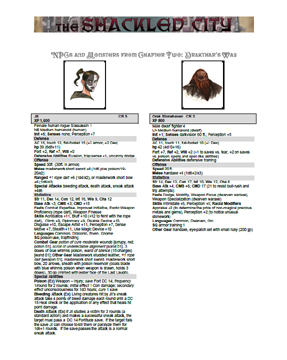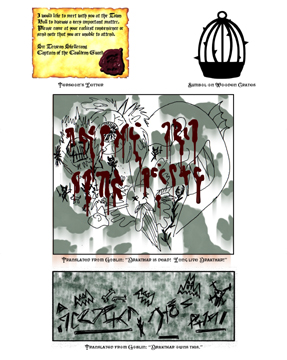Currently I am running a Pathfinder campaign for my gaming group, and since I never got the chance to use my copy of The Shackled City hardcover while we were playing 3.5 I figured it wouldn’t be too much work to convert to ‘3.75’. In spite of Paizo’s claims of backwards compatibility, you can’t really use 3.5 D&D adventures off the shelf for Pathfinder. Most of it works, but the monsters and NPCs in particular are too weak to be a real challenge to a party of Pathfinder characters. Converting the stat blocks isn’t impossible, but it does take time, and since I’m doing the work anyway (I’m a bit of a stat block perfectionist) I thought I would share (click on the pictures at the end of the article to download PDFs of the updated stat blocks for all the monsters and NPCs as well as some additional handouts I created for the second chapter). You can find a conversion of the first chapter of the adventure path, Life’s Bazaar, as well as Pathfinder-style versions of the Greyhawk gods here.
SPOILER ALERT
Obviously there are a ton of spoilers here, both for the campaign and the adventure. So if you plan on playing in The Shackled City, peeking ahead is going to ruin a lot of the fun. If you are one of my players, it goes without saying that you shouldn’t read any further. You’ve been warned.
Drakthar’s Way
The following changes should be made to the adventure for it to play smoothly using the Pathfinder edition of D&D. Click on the pictures at the end of the article to download a PDF of Pathfinder stat blocks for every NPC and monster in the adventure (when I DM I like to have the monster stat blocks in front of me, instead of having to flip to the back of the book or shuffle through Bestiaries), as well as a few additional handouts useful to the adventure (a remade copy of Terseon’s letter using my version of the Cauldron arms as a seal; the symbol of the Cagewrights burnt onto the storage crates; and a few examples of goblin graffiti – I tried to keep them primitive and crude).
Jil’s Tip
Jil’s total bonus to Disguise, including all modifiers and her disguise self spell, is +25. She has a Challenge Rating of 5 instead of 6.
Rats in the Bathhouse
Orak’s challenge rating is reduced from a 4 to a 3. I kept him the same level in spite of this, since even at CR 4, Orak isn’t much of a real threat to a well-equipped party (he hasn’t got any armor or a decent weapon). The wererats, who are the real combatants in this encounter, are the proper challenge rating.
Wandering Monsters
I used Tricky Owlbear Publishing’s version of the ethereal filcher from the PFSRD, which is only a CR 2 instead of the called for CR 3. Rather than beefing the creature up, I kept it as is, since an encounter with this creature is all about preventing it from stealing your magic items – not protracted combat.
6. Storage
The rules for determining CR for creatures with class levels are slightly different in Pathfinder than 3.5e, which means that 1st level goblin rogues only have a CR or ½ instead of 1. To compensate, I gave them another level in rogue. Alternatively you could keep them as level 1 rogues and increase their numbers.
13. Adept’s Lair
Like the goblin sneaks, in order to maintain a CR of 3, I increased the level of the goblin adepts. Since this only results in more spells, not a new spell level, it shouldn’t be problematic.
17. Silent Wolf Goblins
Normally I try and maintain feat choice between the 3.5e and Pathfinder versions of NPCs. In this case I broke that rule and substituted Mounted Combat for Dodge. The adventure states that the silent wolf goblins get off their mounts to fight on the ground in combat, but I ignored this for a few reasons: it seems like a waste letting the goblin’s high ride checks go unused; the cramped layout of the map means that combat space is at a premium; and most importantly, the image of a dual-wielding goblin riding into battle on the back of a worg is just too awesome to pass up. I also added an extra level of rogue to maintain the creature’s original CR.
26. Mercenary Quarters
To maintain Chorlyndyr’s CR of 4 I added another level of Sorcerer (since it doesn’t result in a new level of spells). However, I kept Kallev at 4th level and lowered her CR to 3 – even with the pair bickering, this is a tough encounter and Kallev has a ton of hit points.
31. Drakthar’s Throne Room
Drakthar’s throne, a unique creature, seemed heavily based off of the 3.5e version of the skeleton, so rather than attempting to translate it, I used a Pathfinder version of the skeleton with enough hit dice to reach CR 3, and added a pair of claw attacks (with damage appropriate to the CR) as well as blindsight.
To create Drakthar I added the vampire template to a stock bugbear (even though technically it should only be added to a creature with at least 5 hit dice), substituted putrefy corpse for create spawn and lowering his energy drain to a single level (the standard two levels seems high for a party of 3rd level characters, and his fast healing is challenge enough all by itself).
35. Half-Orc Mercenaries
Like most of the monsters with class levels in this adventure, I added a level of expert to Xoden and a level of fighter to the Half-Orc mercenaries to maintain their CR.
A Note on Magic Items
In my previous post on the Shackled City, I never explained the strange codes in the lists of NPC gear. It isn’t a typo. One of the practices I picked up DMing 3e games that I’ve carried over into Pathfinder is coding all the magic items in the campaign. There are so many magic items (especially one-shot items like potions and scrolls) that it’s easy to forget where they came from in the time between ‘looting the body’ and getting the item identified. To help keep track of everything, I simply give the players the item’s code when they find it, and refer back to a master list when the item is identified. For potions I also add a visual descriptor to help identify the concoction by sight. Each particular type of potion has a standard description, which helps provide some internal consistency to the game world and speeds up the identification process (my players now know that when they find syrupy, red potions they can start using them immediately to heal).
Tags: 3e, D&D, Game Aids, Pathfinder


I’m SO glad that you’ve taken on this project! Dare I hope that we’ll be seeing the entire Adventure Path converted to the current Pathfinder system? You’d be my personal hero (and I just might attempt to entice you with my family’s secret gorton recipe to boot..!)
8)
Thanks for the encouragement – it’s definitely my intention to convert the whole adventure path. My players are almost finished with Drakthar, so I’ll be working on converting Chapter 3: Flood Season next week (I was slightly disappointed with the vandalism hook of chapter 2, so I’m looking forward to chapter 3 upping the ante in terms of PC motivation).
I’ll hold you to that promise of a secret family recipe – like Krusty the clown I’m a huge fan of pork products 🙂
Thank you so much for converting and even more explaining some of your decisions.
This is great! Thanks for your insight!
We too are just about to finish Chapter 2, and I’m working on Chapter 3. I didn’t do a great job converting (this is my first time DMing), so they’ve been plowing through. I spent a great deal of time converting Drakthar and the Throne (did a similar approach to you), and they’ve been struggling. The Bat Swarms were a nasty surprise to them!
One question, though… when creating the NPCs for PF, are you using the ability stats found in the 3.5 stat block? Or are you doing a point buy to convert them over? I’m working on the Storm Blades right now, and I’m debating building them with full PC classes with the 20 point buy we used to create the PCs, but I didn’t know if that would be too overpowered.
Love the blog, will come back frequently 😉
Thanks! For the conversion of NPCs I’ve just been using the 3.5 ability scores since that saves a lot of work and generally it isn’t the difference in ability scores that makes Pathfinder monsters and NPCs so much beefier (although occasionally they get a +1 somewhere because the increase in level, to match target CR, means they have a level dependant ability increase coming to them).
That’s exactly what I did for my version of the Stormblades (coming soon I swear!). They were definitely still a threat when the PCs met them (the Stormblades are a higher level) – but luckily my players were able to resolve things without bloodshed (which pissed off the Stormblades even more 🙂 ).
Just noticed a possible glitch translating a stat block into german. The half orcs got “Armor Training 1” und Breast Plate. Armor Training and Medium armor means no movement penalty. Am i right or wrong?